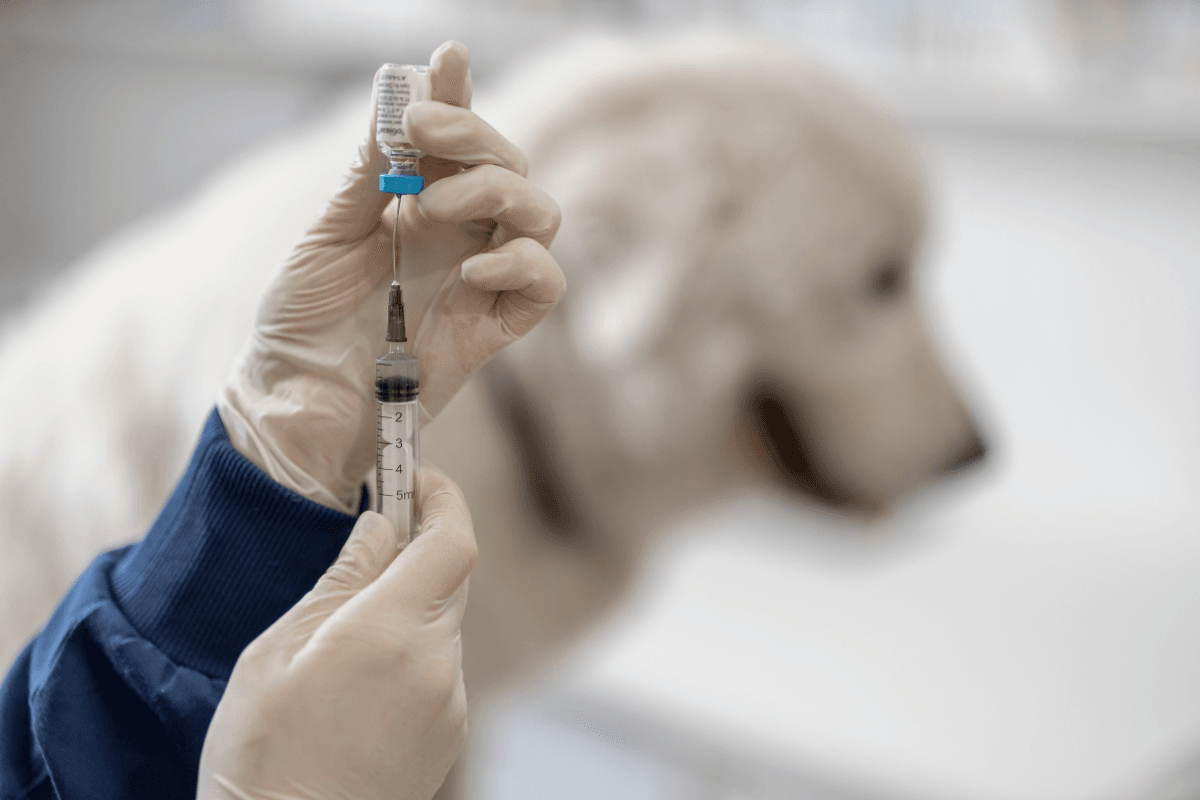Key Takeaways
- Know the insulin type: Humulin N is NPH (intermediate-acting) insulin.
- Consistency helps: Meals, timing, and activity patterns matter daily.
- Use the right tools: Syringe concentration mismatches can cause errors.
- Monitor thoughtfully: Curves and follow-ups guide safer adjustments.
- Plan for lows: Have a vet-approved hypoglycemia response plan.
Hearing that a dog needs insulin can feel overwhelming at first. It often brings a lot of questions about safety, routines, and what “normal” looks like.
If Humulin N insulin for dogs has been discussed by your veterinarian, it helps to understand how this insulin works and what daily care involves. The goal is steadier blood glucose (blood sugar) with fewer surprises.
Below, you’ll find practical, calm guidance on timing, handling, monitoring, and red flags. You’ll also see how Humulin N compares with other options, so conversations with your vet feel easier.
Humulin N Insulin for Dogs: How It Fits Into Canine Diabetes Care
Humulin N is a brand of NPH insulin (neutral protamine Hagedorn), a suspension that acts as an intermediate-duration insulin. In people, it is FDA-approved for diabetes management. In veterinary care, a clinician may sometimes prescribe it “off-label,” meaning it is used outside the human labeling when the veterinarian believes it is appropriate.
That off-label use can be reasonable in some situations, but it also means close follow-up matters. Dogs can respond differently than humans, and even two dogs can respond differently to the same insulin type. For the most accurate handling and storage rules, your vet may reference the FDA labeling along with veterinary guidance.
Humulin N is typically a U-100 insulin (100 units per mL). That concentration affects which syringes are used and how dosing is measured. A quick double-check of the vial and syringe label can prevent mix-ups.
Why this matters: with diabetes, the “right” insulin is the one that fits your dog’s response, your household routine, and the monitoring plan. If you want a broader overview of how clinicians make these choices, you can read Insulin For Dogs for a vet-focused explanation of insulin selection factors.
Is Human Insulin the Same as Dog Insulin?
No, they are not automatically the same, even when the active ingredient is “insulin.” A key difference is that some products are formulated and labeled specifically for pets, while others are made and tested for people. Another important difference is concentration: many veterinary-labeled insulins are U-40, while many human insulins are U-100.
The phrase human insulin for dogs usually means a veterinarian has chosen a human-labeled insulin as part of a dog’s treatment plan. That decision may depend on availability, prior response, caregiver comfort, and monitoring access. It should also include clear instructions about syringes, dose measurement, and what to do when appetite or routine changes.
It can also help to understand what diabetes looks like day to day in pets. If your dog is newly diagnosed or symptoms are changing, Pet Diabetes Symptoms offers a gentle overview of common signs and care priorities.
Note: Never assume two insulins are interchangeable because the names look similar. “Same units” on the label can still measure differently if the concentration or syringe type differs.
Timing Matters With NPH (Humulin N) in Dogs
With NPH insulin, timing is part of safety. NPH has an onset (when it starts lowering glucose), a peak (when effect is strongest), and a duration (how long it continues working). In dogs, those phases can vary widely, based on diet, activity, injection technique, and individual metabolism.
That variability is why many veterinarians lean on glucose curves. A curve is a series of glucose readings over time that shows where the insulin seems to start working, when it peaks, and when it fades. It can be done in-clinic or at home, depending on what your veterinary team recommends and what you feel comfortable doing.
Routines also affect results. Similar meal timing, similar carbohydrate intake, and predictable activity can make insulin action more predictable. When routines change—travel, holidays, new treats, or different exercise—glucose patterns may shift too.
One practical step is to keep a simple log. Note appetite, water intake, energy, bathroom habits, and injection times. These details often help your vet interpret glucose readings more accurately.
Dosing Conversations: Why Charts and Calculators Can Mislead
It’s understandable to search for a “dose-by-weight” reference when you’re trying to keep a dog safe. Still, diabetes dosing is rarely a simple math problem. Online dose charts and calculator-style tools can miss the reasons a dog’s needs change from week to week.
Veterinarians usually consider many factors at once, not just body weight. Food intake, concurrent illness, dental disease, infections, hormone conditions, steroid medications, and stress can all change insulin needs. This is one reason a dog insulin plan is often adjusted based on patterns, not on a single reading.
Home monitoring may be part of those conversations. Some families use a blood glucose meter, while others rely on scheduled rechecks and lab tests like fructosamine (a test that reflects average glucose over time). If you’re learning what home checks involve, see Glucose Meter Options for a basic look at common meter features and supplies.
It also helps to know what “high” numbers might mean beyond a missed dose. Persistently high glucose can occur with infection, inflammation, or ketosis risk. If your vet has ever mentioned ketones, the article Diabetic Ketoacidosis can help you understand why prompt evaluation matters.
Giving Injections and Storing Humulin N Safely
Humulin N is a suspension, so it needs gentle mixing before use. Many clinicians recommend rolling the vial or pen gently between your hands rather than shaking. Shaking can create bubbles and make dosing harder to measure consistently.
Injection technique can also affect absorption. A consistent site rotation plan helps reduce irritation and scar tissue. Many caregivers find it easier to use the same general area, but rotate slightly each time. Your veterinary team can show the safest areas for your dog’s body type and coat.
Choosing syringes and preventing concentration mix-ups
Ask your veterinarian to confirm the exact syringe type and needle size that matches your insulin. The phrase insulin syringes u-100 vs u-40 for dogs matters because the wrong syringe can deliver the wrong volume, even if the “unit” marks look familiar. If you’re comparing markings and sizes, Insulin Syringes can be a helpful reference for common syringe formats and labeling.
Storage is the other half of safe use. Most NPH products are stored refrigerated before opening, and they should not be frozen. Heat exposure, direct sunlight, and repeated temperature swings may reduce effectiveness over time. Your vet may also advise discarding insulin if it looks clumpy, discolored, or unusually stringy for that product.
Tip: Keep insulin, syringes, and a printed schedule in one spot. It reduces missed doses and accidental double-dosing during busy days.
Low Blood Sugar: What to Watch for During Treatment
Hypoglycemia (low blood sugar) is one of the most important safety concerns with insulin. The signs can be subtle at first, and they may look different from dog to dog. Having a clear plan makes it less scary and more manageable.
Common signs of hypoglycemia can include sudden weakness, wobbliness, confusion, tremors, unusual sleepiness, or collapse. Some dogs may seem “off,” anxious, or less responsive. The phrase signs of hypoglycemia in diabetic dogs on insulin is widely searched for a reason: low glucose can progress quickly, so early recognition matters.
What to do next should come from your veterinarian’s instructions. Many clinics provide a written “low glucose” plan that fits your dog’s size, risk level, and other health conditions. Some plans involve fast-acting sugar sources, while others emphasize immediate emergency evaluation. For caregivers who are building an emergency kit with clinician guidance, Dextrose can be a reference point for what a fast-acting glucose product is, and Glucagon Injection Kit With Diluent shows the type of rescue medication sometimes used in severe cases under medical direction.
Side effects are not only about lows. Injection site irritation, appetite changes, and weight shifts can happen during diabetes treatment, especially when routines are still settling. For veterinary-focused safety expectations, many clinicians reference the AAHA diabetes guidelines as a standard framework for monitoring and follow-up.
Choosing Among Types of Insulin for Dogs
Not every dog responds best to the same insulin. Vets often consider insulin action profile, concentration, caregiver schedule, and glucose curve results. That broader view can reduce swings and improve quality of life for both dogs and caregivers.
The phrase types of insulin for dogs usually includes several categories: intermediate-acting insulins (like NPH), longer-acting options (including some analog insulins used off-label), and veterinary-labeled insulins designed specifically for pets. Some short-duration insulins may be used in hospital settings for urgent stabilization, but outpatient plans are usually built around longer coverage and predictable meals.
If you want to understand how insulin categories differ in general, Different Types Of Insulin explains onset and duration concepts in plain language. It can make veterinary discussions about “peaks” and “coverage” easier to follow.
| Insulin category | General pattern | Practical considerations |
|---|---|---|
| Intermediate-acting | Noticeable peak, moderate duration | Timing and meals may strongly affect lows |
| Longer-acting | Flatter effect, longer coverage | May reduce peaks, but still needs monitoring |
| Veterinary-labeled formulations | Designed around pet dosing tools | Often use U-40 syringes and pet-specific guidance |
Switching Insulins and Considering ProZinc
Sometimes a veterinarian suggests a switch because glucose curves show an uncomfortable peak, coverage is too short, or routines have changed. Switching insulin types in diabetic dogs is not just a brand swap. Different products can have different concentrations, mixing requirements, and timing profiles.
If your vet is comparing alternatives, you may hear about prozinc insulin for dogs as a veterinary-labeled option used by many clinics. The key questions are usually practical: how it fits your dog’s eating pattern, what syringe type it uses, and what follow-up testing is needed after any transition.
When you’re trying to understand what a veterinary-labeled vial looks like and what information is listed, ProZinc Vial can serve as a neutral example of labeling details and pack formats. That kind of reference can help you double-check concentration and storage instructions with your veterinary team.
After a change, monitoring often increases temporarily. Many vets ask for a new curve or more frequent check-ins, because the safest adjustments are based on observed patterns. If anything feels unclear—timing, meal rules, or what counts as an emergency—ask for the plan in writing.
Recap
Humulin N (NPH) can be part of a safe diabetes plan for some dogs, especially with consistent routines and clear monitoring. The biggest day-to-day safety wins come from using the correct syringe, storing insulin properly, and knowing early signs of low blood sugar.
If you’re weighing insulin options or facing changing glucose patterns, it helps to bring logs, curve results, and appetite notes to your veterinarian. Those details support calmer decisions and fewer surprises over time.
This content is for informational purposes only and is not a substitute for professional medical advice for your personal situation.

